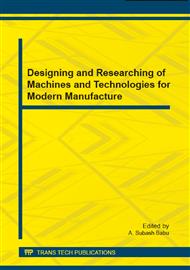[1]
Lachhab I, Krichen L. An improved energy management strategy for FC/UC hybrid electric vehicles propelled by motor-wheels [J]. International Journal of Hydrogen Energy, 2014, 39(1): 571-581.
DOI: 10.1016/j.ijhydene.2013.10.064
Google Scholar
[2]
Wu F, Yeh T J, Huang C. Motor control and torque coordination of an electric vehicle actuated by two in-wheel motors [J]. Mechatronics, 2013, 23(1): 46-60.
DOI: 10.1016/j.mechatronics.2012.10.008
Google Scholar
[3]
Cuesta I I, Lorenzo M, Alegre J M. Response surface application for estimating failure time and other creep properties using the Small Punch Creep Test [J]. Engineering Failure Analysis, 2014: 49-58.
DOI: 10.1016/j.engfailanal.2014.06.023
Google Scholar
[4]
Wang J, Lan S, Li W. Numerical simulation and process optimization of an aluminum holding furnace based on response surface methodology and uniform design [J]. Energy, 2014: 521-535.
DOI: 10.1016/j.energy.2014.05.077
Google Scholar
[5]
Basak N, Jana A K, Das D. Optimization of molecular hydrogen production by Rhodobacter sphaeroides O.U. 001 in the annular photobioreactor using response surface methodology [J]. International Journal of Hydrogen Energy, 2014, 39(23): 11889-11901.
DOI: 10.1016/j.ijhydene.2014.05.108
Google Scholar
[6]
Faghihi V, Reinschmidt K F, Kang J H. Construction scheduling using Genetic Algorithm based on Building Information Model [J]. Expert Systems with Applications, 2014, 41(16): 7565-7578.
DOI: 10.1016/j.eswa.2014.05.047
Google Scholar
[7]
Albayrak M, Allahverdi N. Development a new mutation operator to solve the Traveling Salesman Problem by aid of Genetic Algorithms [J]. Expert Systems with Applications, 2011, 38(3): 1313-1320.
DOI: 10.1016/j.eswa.2010.07.006
Google Scholar
[8]
Nariman-Zadeh N, Salehpour M, Jamali A, et al. Pareto optimization of a five-degree of freedom vehicle vibration model using a multi-objective uniform-diversity genetic algorithm (MUGA)[J]. Engineering Applications of Artificial Intelligence, 2010, 23(4): 543-551.
DOI: 10.1016/j.engappai.2009.08.008
Google Scholar
[9]
Yazdi H A M, Sulong N H R. Optimization of Off-Centre bracing system using Genetic Algorithm [J]. Journal of Constructional Steel Research, 2011, 67(10): 1435-1441.
DOI: 10.1016/j.jcsr.2011.03.017
Google Scholar


